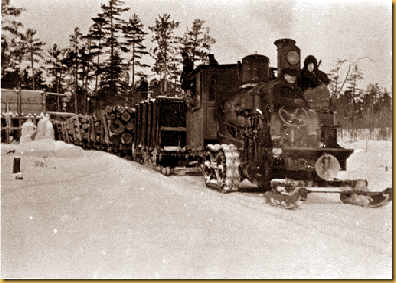

I happened upon information about a Class D Shay while researching Shays in general just to gather historical background about my Class C Shay (3-truck Shay). I got to wondering if anybody had modeled a Class D. It appears that Accucraft did at one time make a live steam version. I can find no current reference to it on their web site, could only find one still photo, and found one YouTube video of a live steam Class D in action. Other than that, no G-scale models seem to exist (there are O- and HO-scale models). So I decided it would be a fun idea to build a G-scale Class D Shay.
The Shay locomotive was invented by Ephraim Shay who built the first one for his own use in his lumber operation in Michigan. Lumbering railways were built quickly and poorly, needing to last just long enough to get the timber out of the area. Traditional rod style locomotives went too hard on the track. The goal of the Shay was smaller drive wheels that delivered equal torque to both sides. Shay wanted to keep his invention a secret because the locomotive reduced his labor cost so significantly, he could sell lumber far cheaper and beat out all competition. An article published in 1877 in the Lumberman's Gazette ended the secrecy, and the entire lumber industry wanted Shays. The local machine shop that built Shay's first locomotive, plus a few for his friends, was overwhelmed. That's when production started at Lima Machine Works, and the first Lima Shay was completed in 1878.
There were 2,767 Shays were built over 67 years under four company names, all variations of Lima Machine or Lima Locomotive. As of now, 114 of the Shays survive, with a few still operational as a tourist attraction. According to the Shay database, there were 81 Shay's operating in Minnesota in the early 1900's.
| Class | Configuration | No. Built | Weight |
| A | 2-cylinder/2-truck | 686 | 10-20 ton |
| Special | 2-cylinder/3-truck | 1 | |
| B | 3-cylinder/2-truck | 1480 | 24-60 ton |
| C | 3-cylinder/3-truck | 580 | 70-125 ton |
| D | 3-cylinder/4-truck | 20 | 100-150 ton |
Visit the Shay Locomotive site for a complete database of Shay's with over 1500 photos.

It's hard to tell, but I think this might have been one of the early Class A Shay's, or maybe even one of Ephraim's own originals. This one required more than one engineer - one in back (where the engineer normally was) to run the steam engine, and another in front to steer!
This picture is cross-linked from the blog where it was originally posted. If the picture is gone, it means the blog went away.


To complete my Class D project, good timing and good luck got me two brand new Bachmann 3-truck Shays on eBay at a very reasonable price. I robbed the tank car (tender) from one to make a bigger tank car on the other, and swapped a couple of trucks around. The Shay I stole from will not be wasted - all I need to do is extend the coal hopper to include a water tank, and it will be a perfect replica of a Class B (2-truck) Shay while the other Class C turns into a Class D. I still end up with two perfectly functional and prototypical Shays!








Just in case you didn't put this together, "B&SC" is Birchwood & St. Croix Railroad.
Click the movie icon below to see a short video clip of the Class D Shay in action, close up. The chuff sound isn't working, but the visual of the drive train is good.

My initial attempt at chuff sensors to replace the original not-so-good chuff sensors did not prove to be robust. So while I had everything apart, I removed my initial attempt. Then I glued a tiny rare earth magnet on top of one of the stroke rods, and glued a tiny reed switch inside the cylinder. I also purchased a new Phoenix sound board to replace the generic (rod style) steam sound. I ordered the Phoenix board with Shay sound preloaded, and then set the chuff multiplier to give the correct number of chuffs off of one sensor. I now have real Shay sound!

Early on, I was worried about how to be perfectly prototypical. After reviewing lots of old photos of Shays, I realized original Shays did not all look exactly alike. My model doesn't look exactly like any of the photos, but no one photo of a real Shay looks like any of the other photos either. I am satisfied that my end result can be reasonably called prototypical.